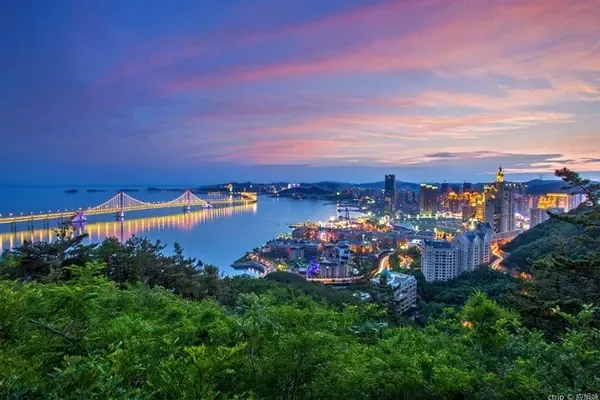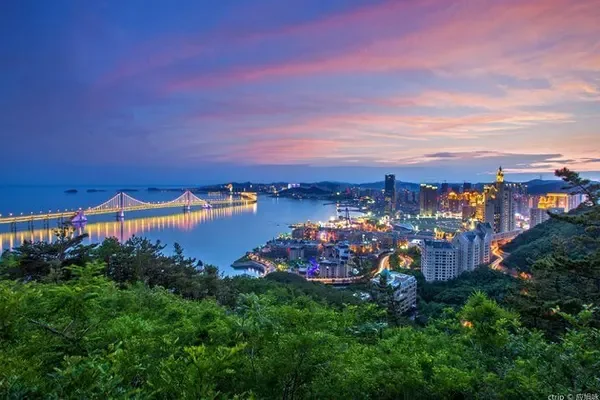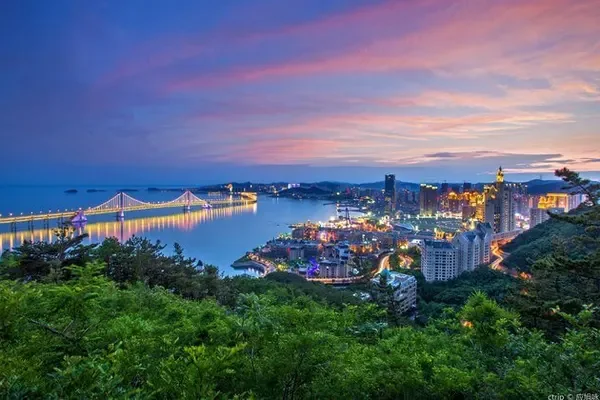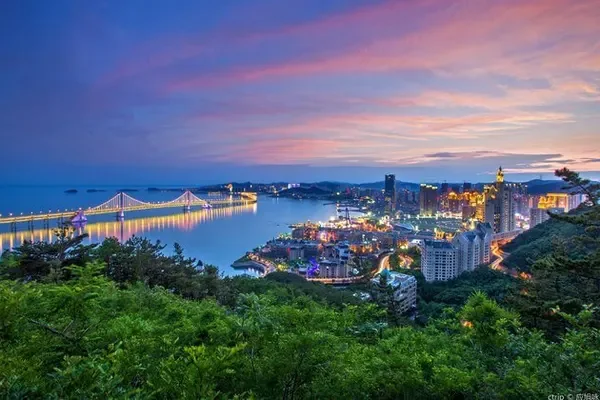Today's tour destination is the famous Kizil Grottoes, also known as Kizil Thousand Buddha Caves.
This is the earliest large-scale grotto group excavated in China, and it is also the most important cultural relic of the ancient Kucha Kingdom. During the Western Han Dynasty, the Kingdom of Qiuci was the largest oasis kingdom among the thirty-six countries in the Western Regions, and it was one of the four Anxi towns in the Tang Dynasty. Mr. Ji Xianlin once said: "Kuici is the only place in the world where ancient Indian, Greek, Roman, Persian, and Han and Tang civilizations meet."

Illustration: To go from Kuqa to the Kizil Grottoes and the Mysterious Hero Valley of Tianshan, you need to take a section of Duku Highway first, and then diverge at the fork of S307 Highway.

Kyzylia mountain landscape
I have driven more than 20 kilometers on the G217 (Duku Highway) and will soon turn to the S307 Highway. The street signs show that this area is called the Saltwater Ditch Scenic Area. The strange rocks on both sides are various and changeable in color, taupe, khaki, brown red... ..., the color change of the mountain is due to the different mineral elements contained.

There is a viewing platform and a special parking lot in front of the Yanshuigou Tunnel. What you see in front of you is a continuous red mountain, which is similar to the landform of the Tianshan Mysterious Grand Canyon that you visited yesterday.

This place is also known as the Kizilia mountain landscape. "Kizilia" is a Uighur language, meaning "red cliff".

There is a stone tablet beside the road, which introduces the Duku Highway and is supplemented by a guide map.

The rock behind the stele is engraved with golden patterns and red poems.

A poem from the Qing Dynasty: Cangyan is horizontal and the blue is falling, rest your horse and change your clothes.....

look up at the sky

The salt water ditch tunnel pierces the red mountain rock.

Saltwater Ditch is a dry riverbed that crosses the Quertag Mountain, named for the high salt content of the water in the ravine. Shuiyangou is the old route of the ancient Silk Road, the throat from the ancient Qiuci country to the Gumo country, and it was also a famous ancient military pass.



This rock is called "Potala Palace Landscape" and it is listed on the Duku Highway Guide Map. The mountains and rocks seem to have corridors and columns, towers and pavilions, and scattered pavilions, but they are not very similar. This kind of name is nothing more than to stimulate and expand the imagination of the viewer. If you think about it hard, it seems to have some meaning. Tourists who come here for the name basically come here to visit, check in and take pictures, and will not be entangled in this.





Kizil Grottoes
The total distance from Kuqa City to Kizil Grottoes is 67 kilometers. After winding for a long time on the S307 highway, the terrain ahead suddenly opened up, and there were green vegetation on the roadside.

After continuing to drive for a while, a large oasis appeared in the valley. The trees were tall and lush, and the houses were hidden among them, and we had already arrived at the location of the Kizil Grottoes. The Kizil Grottoes were successfully included in the "World Heritage List" as a site in the "Silk Road: Road Network of Chang'an-Tianshan Corridor" jointly applied by China, Kazakhstan and Kyrgyzstan.

The gate of the scenic spot is written: Silk Road: Road Network of Chang'an-Tianshan Corridor. How many pictures from the past and the present have been conjured up with just a few numbers, which is full of imagination and emotion.

There is no traffic vehicle in the scenic area, and you need to walk through a boulevard, which is more than 1 km long.

Today's weather is not so good, cloudy, strong wind blows dust, and rain falls from time to time.

The poplar trees in Xinjiang are different from those in the mainland. They are tall and straight, growing vertically, like warriors lined up to welcome visitors from afar.

The color of the mountain is yellow-brown, which looks like the color of the Loess Plateau from a distance, but layers of folds and strange rocks protrude, showing the unique landform characteristics of Kuqa.


The Kizil Grottoes, Chinese Buddhist grottoes, are located on the cliff of Mingwutag Mountain, 7 kilometers southeast of Kizil Town, Baicheng County, Xinjiang, with the Muzhat River Valley to the south.

Kizil Grottoes, as the earliest known large-scale Buddhist cave temple site in China, has outstanding universal value in the world, especially the originality and diversity of murals, which has become one of the outstanding achievements of Kizil Grottoes art and is also a Buddhist temple. It is a great pioneering work in the history of art, and it is also the cradle for the development of Buddhist art.

The statue of Jinmaluojiva, Jinmaluojiva is a famous eminent monk in ancient China, together with Zhidi and Xuanzang, he is also known as the three major translators of Chinese Buddhism. He and his disciples translated a total of 74 Buddhist scriptures and 384 volumes, making an indelible contribution to Chinese Buddhist culture.

The bungalow on the left is the storage place for items. Bags and cameras need to be stored. It is allowed to take pictures with mobile phones in the grotto (cameras are not allowed to take pictures).

The Kizil Grottoes are layered and scattered in the east-west direction on the cliff body of Mingwutag, which stretches for about 1.7 kilometers, and are divided into four grotto distribution areas according to the natural trend of the mountain, namely, the valley west area, the valley inner area, and the valley east area. In Hehoushan District, 349 caves have been discovered so far, 236 caves have been numbered, and about 10,000 square meters of murals and some painted statues remain, as well as the remains of many architectural components in front of the caves.

The Kizil Grottoes are the earliest and westernmost large-scale grottoes in China. They were excavated in the 3rd century AD and gradually ceased construction in the 8th-9th century AD. The duration is unique in all countries in the world.

The Kizil Thousand Buddha Caves are built on this high cliff. The caves are layered and orderly, including the "Zhiti Cave" for worshiping Buddha statues, the "Vihara Cave" for monks and nuns to retreat or give lectures, the living quarters for monks and nuns, and the Arhat Cave for burying ashes. Wait, such a complete architectural system is rare in other Buddhist centers in the world.




At present, 6 caves are open, and tourists are organized into a group of 8 people, and the guides will guide them into the caves to visit.

The Kizil Grottoes are famous all over the world for their long history and profound culture and art. But the status quo of the grottoes is full of devastation, which is heartbreaking: the vaulted niche where Sakyamuni Buddha was placed is empty; the left half of the Buddha statues on the murals were looted because it was made of gold leaf; even the murals on the entire wall were destroyed. Take it away, leaving only the traces of chiseling on the cave wall....

At the end of the 19th century and the beginning of the 20th century, foreign expeditions came to the Kizil Grottoes many times, separated a large number of exquisite murals and sculptures from the mother cave, and transported them to foreign countries, so that these beautiful Kucha artworks were scattered all over the world.




At present, among the more than 200 grottoes in the Kizil Grottoes, most of the statues have been destroyed, and there are 81 caves with exquisite murals, and more than 10,000 square meters of murals are preserved. However, museums and art galleries in some Western countries, especially the Berlin Asian Art Museum in Germany, display a large number of Kizil Grotto murals looted from Xinjiang.




Several large exhibition boards are placed in this cave. The exhibition boards are replicas of the murals of the Kizil Grottoes, and some of the original murals are collected in the Kunstmuseum Berlin, Germany.


The display panel in the picture below: 4 standing portrait murals, which are the outer wall of the right corridor of Cave 8, and the original works are collected in the Asian Art Museum in Berlin, Germany

The display panel in the picture below: the mural on the far left, Heaven and Man and the Bhikkhu (part of the picture of Karma Buddha), the right wall of the main room of Cave 186, the original work is now collected in the Asian Art Museum in Berlin.

Authentic photos of Heaven, Man and Bhikkhu are in the collection of the Asian Art Museum in Berlin, Germany.


From 1902 to 1914, the German expedition conducted four expeditions along the northern route of the Silk Road in Xinjiang, China. In 12 years, a total of 423 boxes of rare cultural relics were transported back to Germany. Including early Buddhist murals, various artifacts unearthed by archaeology, ancient architectural components, and ancient painting fragments on paper and silk, collectively referred to as the "Turpan Collection". In fact, most of the "Turpan Collection" comes from Kuqa, Xinjiang (the seat of the ancient Kucha Kingdom), among which the Kizil Grottoes murals are the most important. A few more authentic photos:
Bottom: The story of the Buddha’s biography “Support by Heaven and Man”, the upper front end of the left end wall of the back room of Cave 8, collected in the Asian Art Museum in Berlin, Germany

Bottom: The dome of the main room of Cave 129, which is housed in the Asian Art Museum in Berlin, Germany

Bottom: Garuda Cave 198A, the central ridge on the top of the main room, collected in the Asian Art Museum in Berlin, Germany











The Kizil Grottoes are backed by dangerous mountains and facing river valleys. The trees are shady and the environment is quiet. It is a beautiful oasis in the desert.





The murals in the Kizil Grottoes not only have the influence of Han culture, but also the application of foreign culture and art, full of the extraordinary wisdom of the ancient Kucha painters. They use rough and powerful lines to outline the strong and solid bones, to dye the rich and round skin, and to draw evenly arranged folds with a light stroke. With the help of a long floating belt, they show the artistic conception of flying in the air and flying freely. . Those "flying" portraits are full of the feeling of "the sky is flying, and the wall is full of wind".





The last cave to visit is No. 10, which was originally used as the residence of monks. There are a group of photos of modern figures (more than half a century ago), and a "Certificate of Revolutionary Martyrs" issued by Chairman Mao Zedong in 1956. Comrade Han Leran was awarded as a revolutionary martyr.

Han Leran, a Korean art artist, joined the Communist Party of China in 1923 and went to study in the Soviet Union in the 1920s. After returning to China, as an art teacher, he secretly engaged in high-level national united front work in the Northeast and Northwest regions. In 1946, he visited the Kizil Grottoes, copied the murals, and recorded the condition of the caves at that time. Then in 1947, he brought several friends and students to systematically number, organize and record the Thousand Buddha Cave Grottoes, making a great contribution to the protection of the Grottoes. He died in a plane crash a few months later at the age of 49.

Buddha Riding an Elephant and Monkey Presenting Fruits (Kizil Cave 38) Han Leran Oil Painting Copy

Uighur Baked Naan Han Leran Watercolor














There are several tall mulberry trees beside the road, with white mulberries hanging on the branches. A tourist said it was very sweet after eating it.



Baicheng Village
It was less than 13 o'clock when we left the Kizil Grottoes. At this moment, the sky was clear, white clouds were flowing, green trees and flowers. There is nothing else to do today, just take the car, enjoy the scenery, relax, and feel happy.

Roadside villages, idyllic scenery, restaurants and shops, stop to find something to eat, and watch the local customs by the way.

This is the second group of Harmony Village, Kangqi Township, Baicheng County. It is located beside the S307 highway, 56 kilometers away from the Kizil Grottoes.

Naan


baked buns


The freshly baked buns are hot to the touch, delicious!

Xinjiang big watermelon




The village is 5 kilometers away from Baicheng County, and then the car drove through the county, a beautiful city.
Glimpse of the journey
Illustration: Starting point: Kizil Grottoes, ending point: Bachu County, 466 kilometers, with Aksu in the middle.

I thought today would be relatively easy. After visiting the Kizil Thousand Buddha Caves, the rest is to run straight to Bachu County. It will be easy to arrive, but who knows otherwise...


There was a traffic jam on the expressway from the Aksu toll station; then there were multiple inspections; after half an hour out of the service area, I was stopped again and had to stop for 20 minutes and told that that was Aksu and this was Kashgar; Nucleic acid testing, waiting in line, wasted a lot of time, and made people physically and mentally exhausted.




Bachu County
I bought naan, baked buns, and big watermelons from the village in Baicheng County on the roadside, and finally entered the Bachu toll station. I walked for nearly 7 hours on a road of more than 400 kilometers, and it was 20:47 at this moment.

Checking into the Hongjin Hotel in Bachu County, I had to scan the code at the front desk and register for a long time. After going upstairs, I couldn’t open the door, and went downstairs again to the front desk to swipe the room card.

There is a Uighur restaurant downstairs in the hotel: fried noodles with noodles, pilaf with minced meat, big plate chicken, and barbecue, which seems to be a little bit worse.

I have been busy running around during the day and didn't have a serious meal, so I am ready to reward myself in the evening. When you come to the bustling downtown of the county town, find a unique restaurant to feast on.


Bachu's grilled fish is very famous, so I found a famous barbecue restaurant.

The decoration of the restaurant is full of local characteristics. Looking at the menu, the word "roast" is everywhere.


I really want to visit the roasting site. The waiter enthusiastically led us to the backyard where the pit fire was flourishing and the smoke was lingering.

grilled fish

Marinated Lamb Chops Before Grilling

roast chicken

I ordered a plate of scrambled eggs with tomatoes. The tomatoes in Nanjiang are super delicious, and the color after frying is bright red and attractive!

roast pigeon

Roast lamb

Ba Chu Grilled Fish

Because you can't eat chili, the taste of grilled fish, meat, and pigeons is greatly reduced.

After the meal, take a taxi back to the hotel. The taxis passing by are rarely empty, so the tip is a little tricky. Even though it is a county seat, the streets are bustling, brightly lit, and very popular. It was nearly 24:00 when I returned to the hotel. I came to Xinjiang for tourism. I really couldn’t stand it without paying for my health.

Going out early in the morning, the hotel is located on the edge of the county seat, there is nothing to see around, and the breakfast is even more disappointing. But this is normal. When traveling, especially in remote areas, you have to be comfortable with eating and staying in hotels, and you should not expect too much.

Bachu County is located at the southern foot of the Tianshan Mountains, on the edge of the Tarim Basin and the Taklamakan Desert. It is the transportation hub of southern Xinjiang and the east gate of Kashgar. Bachu is the birthplace of Populus euphratica culture in Xinjiang and the hometown of Daolang Dance. It has profound cultural heritage, rich folk customs and rich tourism resources. There are historical and cultural relics such as Tang Wangcheng, ancient beacon ruins, and Karamdarbaek ancient tomb, as well as natural landscapes such as golden Populus euphratica, desert scenery, and plain lakes. This morning, I will choose one or two to see the style.



